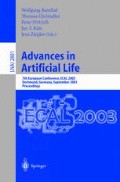Abstract
This paper demonstrates that the waves produced on the surface of water can be used as the medium for a “Liquid State Machine” that pre-processes inputs so allowing a simple perceptron to solve the XOR problem and undertake speech recognition. Interference between waves allows non-linear parallel computation upon simultaneous sensory inputs. Temporal patterns of stimulation are converted to spatial patterns of water waves upon which a linear discrimination can be made. Whereas Wolfgang Maass’ Liquid State Machine requires fine tuning of the spiking neural network parameters, water has inherent self-organising properties such as strong local interactions, time-dependent spread of activation to distant areas, inherent stability to a wide variety of inputs, and high complexity. Water achieves this “for free”, and does so without the time-consuming computation required by realistic neural models. An analogy is made between water molecules and neurons in a recurrent neural network.
Access this chapter
Tax calculation will be finalised at checkout
Purchases are for personal use only
Preview
Unable to display preview. Download preview PDF.
References
Maass, W., Natschlager, T., et al.: Real-Time Computing Without Stable States: A New Framework for Neural Computation Based on Perturbations. Neural Computation 14, 2531–2560 (2002)
Hopfield, J.J., Brody, C.D.: What is a moment? ”Cortical” sensory integration over a brief interval. PNAS 97(25), 13919–13924 (2000)
Auer, P., Burgsteiner, H., et al.: The p-Delta Learning Rule for Parallel Perceptrons (2002) (submitted for publication), http://www.cis.tugraz.at/igi/pauer/publications.html
Adamatzky, A.: Computing in nonlinear media: make waves, study collisions. In: Kelemen, J., Sosík, P. (eds.) ECAL 2001. LNCS (LNAI), vol. 2159, pp. 1–11. Springer, Heidelberg (2001)
Adamatzky, A., De Lacy Costello, B.P.J.: Experimental logical gates in a reaction-difusion medium: The XOR gate and beyond. Physical Review E 66, 46112 (2002)
Goldenholz, D.: Liquid Computing: A Real Effect. BE707 Final Project. Boston University School of Medicine, Boston (2002), http://www.lsm.tugraz.at/people.html
MacLennan, B.: Field Computation in Natural and Artificial Intelligence. Knoxville, University of Tennessee. Report UT-CS-99-422. (1999), http://www.cs.utk.edu/mclennan/fieldcomp.html
McCulloch, W.S., Pitts, W.: A logical calculus of the ideas immanent in nervous activity. Bulletin of Mathamatical Biophysics 5, 115–133 (1943)
Freeman, W.: Mesoscopic Neurodynamics: From neuron to brain. Journal of Physiology (Paris) 94, 303–322 (2000)
Walmsley, I.: Computing with interference: All-optical single-query 50- element database search. In: Conference on Lasers and Electro-Optics/Quantum Electronics and Laser Science, Baltimore, Maryland (2001)
Tononi, E., Sporns, O.: Complexity and Coherency: integrating information in the brain. Trends in Cognitive Sciences 2(12), 474–483 (1998)
Muller, G., Newman, S.: Origination of Organismal Form: Beyond the Gene in Developmental and Evolutionary Biology. MIT Press, Cambridge (2003)
Author information
Authors and Affiliations
Editor information
Editors and Affiliations
Rights and permissions
Copyright information
© 2003 Springer-Verlag Berlin Heidelberg
About this paper
Cite this paper
Fernando, C., Sojakka, S. (2003). Pattern Recognition in a Bucket. In: Banzhaf, W., Ziegler, J., Christaller, T., Dittrich, P., Kim, J.T. (eds) Advances in Artificial Life. ECAL 2003. Lecture Notes in Computer Science(), vol 2801. Springer, Berlin, Heidelberg. https://doi.org/10.1007/978-3-540-39432-7_63
Download citation
DOI: https://doi.org/10.1007/978-3-540-39432-7_63
Publisher Name: Springer, Berlin, Heidelberg
Print ISBN: 978-3-540-20057-4
Online ISBN: 978-3-540-39432-7
eBook Packages: Springer Book Archive

